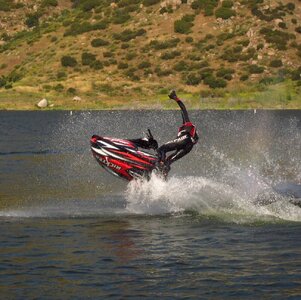- Location
- The Lake
Several months ago I picked up a Carbon Kevlar Rickter FS-2 hull from Freestyle Connection. I figured I'd start this thread to document the build and to solicit advice from those who have more experience building skis than I do. I believe this used to be Taylor Curtis's old hull. I'm not sure if anyone else besides Taylor owned this hull prior to Chris. I'm assuming so based on the 2019 registration sticker.
To make a long story short, I've been mulling over picking up an aftermarket hull to replace my beat up round nose Superjet for some time now. Personally, I enjoy the way the Superjet hull rides and I'm usually on the lake chasing boats so I didn't want a hull that was too flat water focused. I would day dream about buying and building a ZaxJet 2Ride but I could never bring myself to spend the money considering I really don't ride too terribly often.
My brother and the friends I ride with all called me dumb for wanting an aftermarket Superjet hull; so I went and bought a Rickter FS-2. When I was younger my brother had a Rickter FS-2 that he absolutely loved and raves about to this day. Unfortunately I never had the chance to ride it before it was sold so I'm going in blind here. Fingers crossed I don't end up regretting this purchase, though I don't believe I will.
My plan is to take the guts from my Superjet and transfer them over to this hull. I'll be running the following:
- 61x / 62t - Ported 718cc - built by @Jr.
- Factory B-Pipe W/ ported manifold
- Aftermarket Head + Pump Gas Domes
- OEM SBN 38s + VForce 3 Reeds
- MSD Enhancer
- 148mm Torrent Setback Pump


To make a long story short, I've been mulling over picking up an aftermarket hull to replace my beat up round nose Superjet for some time now. Personally, I enjoy the way the Superjet hull rides and I'm usually on the lake chasing boats so I didn't want a hull that was too flat water focused. I would day dream about buying and building a ZaxJet 2Ride but I could never bring myself to spend the money considering I really don't ride too terribly often.
My brother and the friends I ride with all called me dumb for wanting an aftermarket Superjet hull; so I went and bought a Rickter FS-2. When I was younger my brother had a Rickter FS-2 that he absolutely loved and raves about to this day. Unfortunately I never had the chance to ride it before it was sold so I'm going in blind here. Fingers crossed I don't end up regretting this purchase, though I don't believe I will.
My plan is to take the guts from my Superjet and transfer them over to this hull. I'll be running the following:
- 61x / 62t - Ported 718cc - built by @Jr.
- Factory B-Pipe W/ ported manifold
- Aftermarket Head + Pump Gas Domes
- OEM SBN 38s + VForce 3 Reeds
- MSD Enhancer
- 148mm Torrent Setback Pump

















